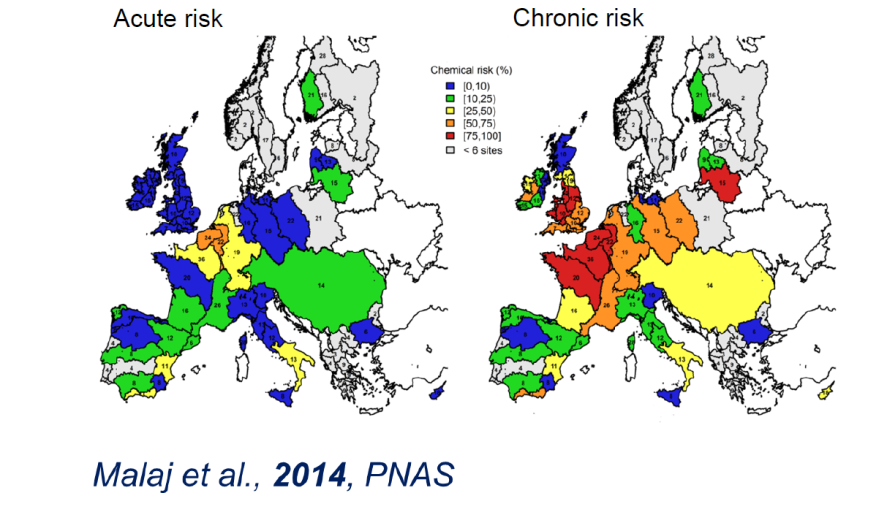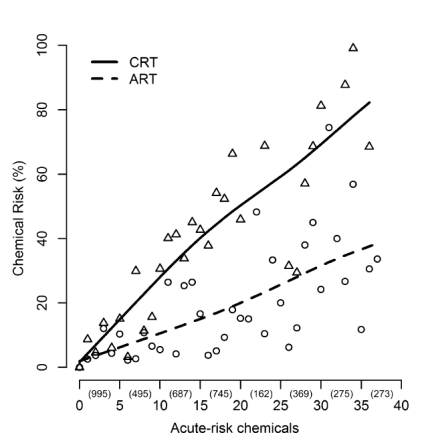Post a comment on the text below
A pioneering study by Malaj et al. (2014) used monitoring data on chemical concentrations, based on data reported in WISE–SoE. The authors considered more than 200 substances monitored in European freshwater systems. They reported an acute risk at 14% and a chronic risk at 42% of the sites investigated (figure 2.4 A). One issue identified using this approach, however, is that the expected risk increases with the availability of chemical monitoring data. Where concentrations are unknown, they cannot be used in the assessment and so this may result in a skewed result, with sites for which information is available appearing worse than those for which this information is not provided (figure 2.4 B). A further issue is that the availability of data for acute toxicity is much greater than that for chronic toxicity, meaning that the chronic risk assessment is more dependent on assessment factors and thus prone to larger errors.
Figure 2.4: A) Acute and chronic risk estimates for European water bodies based on reported chemical monitoring data and calculated using risk estimates for individual compounds;

Fig 2.4 B) Correlation between chemical risk and number of chemicals analysed for acute risk (ART = acute risk threshold, CRT = chronic risk threshold); figures from Malaj et al. 2014)

Recent research indicates that chemicals contribute to a significant but varying extent to the total effective stress in river ecosystems (Schäfer et al. 2016, Rico et al. 2017). Rico and colleagues (2016) showed that variation in invertebrate communities could be mainly explained by habitat and water quality, with physico-chemical parameters (e.g. dissolved oxygen) explained more of the variation than metals or organic contaminants. The authors reported that it was difficult to find direct links between individual contaminants and ecological effects.
In the EEA's RBMP Assessment (EEA, 2018a), it is highlighted that countries with good ecological status for benthic invertebrates also have lower levels of pressures. This seems true especially for diffuse pollution and hydromorphological pressures. To identify e.g. pressure-related failures of good ecological and chemical status might require a second line of assessment, beyond the prevailing basic one-out all-out principle. Such studies could be successful with pollutant concentrations instead of EQS exceedances and organism compositions instead of biological quality element classes.
In conclusion, it is rarely possible to explain observed effects in ecosystems based on knowledge about the presence of individual chemicals, while ecological impact information alone is similarly not sufficient to identify the chemicals causing that impact. Instead multiple lines of evidence are needed.
You cannot post comments to this consultation because you are not authenticated. Please log in.



Previous comments
P17 Reliance on large AFs introduces variability between EQSs and (probably) over-protection. Only substances with enough data for a small AF should be put forward as regulatory EQSs (suggest minimum AF of 50).
P17 Links between chemical status and ecological status. Work by Malaj et al 2014 suggests a link but this doesn’t seem to be borne out in assessments of impact (i.e. ecological status). Does this highlight a difference between RISK and IMPACT? i.e. you can identify a risk but this isn’t necessarily translated into impact on biological communities. This raises quite an important question - What should drive action? Evidence of risk or evidence of impact?